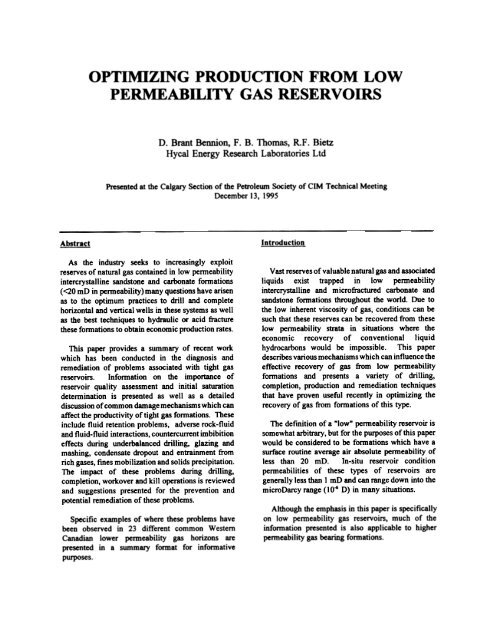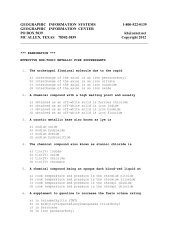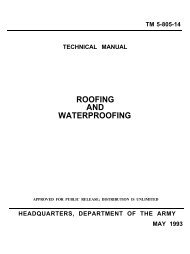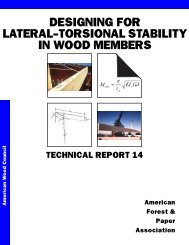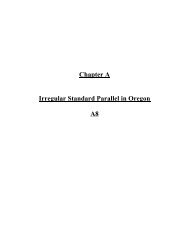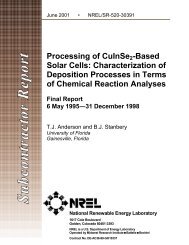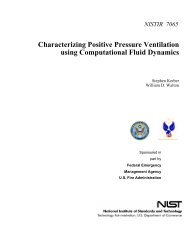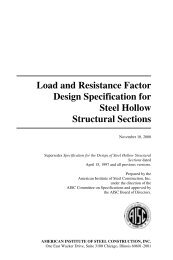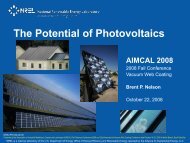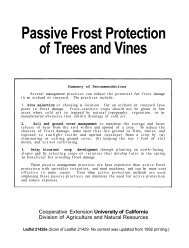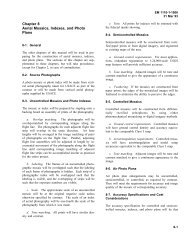Optimizing Production from Low Permeability Gas Reservoirs
Optimizing Production from Low Permeability Gas Reservoirs
Optimizing Production from Low Permeability Gas Reservoirs
Create successful ePaper yourself
Turn your PDF publications into a flip-book with our unique Google optimized e-Paper software.
Abstract<br />
OPTIMIZING PRODUCnON FROM LOW<br />
PERMEABILITY GAS RESERVOIRS<br />
D. Brant Bennion, F. B. Thomas, R.F. Bietz<br />
Hycal Energy Research Laboratories Ltd<br />
Presented at the Calgary Section of the Petroleum Society of CIM Technical Meeting<br />
December 13, 1995<br />
As the industry seeks to increasingly exploit<br />
reserves of natural gas contained in low penneability<br />
intercrystalline sandstone and carbonate fonnations<br />
«20 mD in penneability) many questions have arisen<br />
as to the optimum practices to drill and complete<br />
horizontal and vertical wells in these systems as well<br />
as the best techniques to hydraulic or acid fracture<br />
these formations to obtain economic production rates.<br />
This paper provides a summary of recent work<br />
which has been conducted in the diagnosis and<br />
remediation of problems associated with tight gas<br />
reservoirs. Infonnation on the importance of<br />
reservoir quality assessment and initial saturation<br />
detennination is presented as well as a detailed<br />
discussion of common damage mechanisms which can<br />
affect the productivity of tight gas formations. These<br />
include fluid retention problems, adverse rock-fluid<br />
and fluid-fluid interactions, countercurrent imbibition<br />
effects during underbalanced drilling. glazing and<br />
mashing, condensate dropout and entrainment <strong>from</strong><br />
rich gases, fines mobilization and solids precipitation.<br />
The impact of these problems during drilling,<br />
completion, workover and kill operations is reviewed<br />
and suggestions presented for the prevention and<br />
potential remediation of these problems.<br />
Specific examples of where these problems have<br />
been observed in 23 different common Western<br />
Canadian lower permeability gas horizons are<br />
presented in a summary format for informative<br />
purposes.<br />
Introduction<br />
Vast reserves of valuable natural gas and associated<br />
liquids exist trapped in low permeability<br />
intercrystalline and microfractured carbonate and<br />
sandstone fonnations throughout the world. Due to<br />
the low inherent viscosity of gas, conditions can be<br />
such that these reserves can be recovered <strong>from</strong> these<br />
Jow penneability strata in situations where the<br />
economic recovery of conventional liquid<br />
hydrocarbons would be impossible. This paper<br />
describes various mechanisms which can influence the<br />
effective recovery of gas <strong>from</strong> low permeability<br />
fonnations and presents a variety of drilling,<br />
completion, production and remediation techniques<br />
that have proven useful recently in optimizing the<br />
recovery of gas <strong>from</strong> formations of this type.<br />
The definition of a "low" permeability reservoir is<br />
somewhat arbitrary, but for the purposes of this paper<br />
would be considered to be formations which have a<br />
surface routine average air absolute permeability of<br />
less than 20 InD. In-situ reservoir condition<br />
permeabilities of these types of reservoirs are<br />
generally less than I mD and can range down into the<br />
micro Darcy range (10-6 D) in many situations.<br />
Although the emphasis in this paper is specifically<br />
on low penneability gas reservoirs, much of the<br />
iofonnation presented is also applicable to higher<br />
penneability gas bearing forDlations.
-2-<br />
What is the Challenee? effectively predict to location of and penetrate the<br />
If we consider what could cause uneconomic<br />
production rates <strong>from</strong> a low permeability gas bearing<br />
pre-existing natural fractures with the wells or<br />
fracture treatments. Where such penetration has not<br />
occurred, the wells have generally been non viable.<br />
forDlation. the options generally will fall into six<br />
categories, these being; 2. Adverse initial saturation conditions<br />
I. Poor reservoir quality - period!<br />
2. Adverse initial saturation conditions<br />
3. Damage induced during drilling and completion<br />
4. Damage induced during hydraulic or acid<br />
fracturing<br />
S. Damage induced during kill or workover<br />
treatments<br />
6. Damage induced during production operations<br />
Each of these categories will now be reviewed in<br />
more detail.<br />
1. Poor Reservoir Quality - Period!<br />
The saying "You cannot make a silk purse out of<br />
a sows ear" has definite applicability to the field of<br />
tight gas exploitation. Through the use of appropriate<br />
drilling, completion and in some cases large scale<br />
fracturing techniques, some operators have been<br />
amazingly successful in obtaining economic<br />
production rates <strong>from</strong> formations exhibiting in-situ<br />
matrix permeabilities of as low as 10-6 D. Some<br />
reservoir applications, however, are doomed to failure<br />
by the simple virtue of the fact that, no matter how<br />
successful and low damaging our drilling and<br />
completion operations, sufficient in-situ permeability,<br />
pressure, reserves or all of the above are not present<br />
to obtain economically viable wells. The prime<br />
objective of this paper is to identify candidates of this<br />
type, in comparison to those where the judicious<br />
application of the appropriate technology can obtain<br />
economic wells. In general, no documented evidence<br />
exists of economic production <strong>from</strong> formations having<br />
an interconnective matrix permeability of less dlan<br />
10-6 D (even in the presence of successful large scale<br />
fracturing treatments). If an extensive micro or<br />
macrofracture system exists and the well can be<br />
completed without impairing the conductivity of the<br />
natural fractures, then documented cases exist where<br />
viable production has been obtained <strong>from</strong> source<br />
matrix of lower permeability values than 10-6 D.<br />
Penetration of a less extensive microfracture system<br />
by a conventional hydraulic or acid fracturing<br />
treatment, to augment inflow, has also been successful<br />
in some sub microDarcy reservoir applications. Well<br />
successes in these situations have been highly<br />
dependant on geological control and being able to<br />
In many cases, gas exists in low penneability<br />
fonnations of "acceptable" permeability according to<br />
the previous criterion, but. due to adverse capillary<br />
forces, high in-situ saturations of trapped water, and<br />
in some cases, liquid hydrocarbons are present. If<br />
these saturations are too high, economic production of<br />
gas <strong>from</strong> the zone is often difficult due to;<br />
- Limited reserves available for production due to<br />
the majority of the pore space being occupied by<br />
an immobile trapped fluid<br />
- Adverse relative permeability effects caused by<br />
the presence of high immobile fluid saturations<br />
rendering economic production rates impossible<br />
One of the first steps in ascertaining if gas is<br />
economically producible <strong>from</strong> a low permeability<br />
fonnation is the accurate determination of initial fluid<br />
saturations. This process is often difficult due to the<br />
fact that;<br />
- Water saturations calculated <strong>from</strong> logs are often<br />
inaccurate due to limited availability of accurate<br />
"a", "m" and "n" electrical property data to<br />
calibrate field resistivity logs<br />
- Accurate Rw data is often unavailable for these<br />
formations as, due to high capillary trapping<br />
effects, many of these zones do not produce<br />
mobile free water to facilitate accurate<br />
compositional and Rw measurements<br />
- Water saturations evaluated <strong>from</strong> cores drilled<br />
with water based fluids are often elevated due to<br />
core flushing and spontaneous imbibition effects.<br />
Water saturations obtained using air or nitrogen<br />
as coring fluids are often lower then true in-situ<br />
values due to localized heating during the coring<br />
process and core desiccation. Oil-based coring<br />
fluids can result in good water saturation<br />
determinations, but flushing can affect the<br />
accuracy of the measurement of the magnitude<br />
of any trapped initial liquid hydrocarbon<br />
saturation which may be present in the reservoir.<br />
A variety of techniques are available to measure<br />
in-situ water and oil saturations, the best and most<br />
reliable being speciality coring programs in the<br />
producing zone of interest. In zones containing only<br />
an initial water saturation, radioactively traced<br />
(deuterium or tritium) coring fluids can provide an
accurate evaluation of initial water saturation when<br />
coupled with low invasion coring technology (Ref 1).<br />
When both an initial oil and water saturation are<br />
present and we desire to evaluate the true magnitude<br />
of the "free" gas saturation available for reserves<br />
evaluation and recovery, sponge coring, when coupled<br />
with a radioactively traced water based coring system<br />
and a low invasion coring tool can give good results,<br />
as illustrated in Figure 1. It can been seen <strong>from</strong><br />
Figure I that with this data (when the oil volume is<br />
adjusted for gas solubility and swelling effects) one<br />
can accurately evaluate the free gas saturation and<br />
determine if sufficient reserves and relative<br />
permeability exist to obtain a viable and exploitable<br />
play. These techniques have been used in the past to<br />
ascertain initial saturations in formations such as the<br />
Monmey, Gething, Rock Creek, Ostracod, Viking,<br />
Cardium and Jean Marie in Canada and in a number<br />
of low permeability Permian Basin gas fields in the<br />
United States. Although highly related to reservoir<br />
quality, if a free gas saturation of lower than 25-300/0<br />
exists in the media this reduces both reserves and<br />
effective gas permeability below what would typically<br />
be quantified as economically producible values.<br />
3. Formation Damage During Drilling and<br />
Completion<br />
Tight gas reservoirs are very susceptible to<br />
fonnation damage. This is due to the generally<br />
unforgiving nature of low penneability rock in that<br />
we can tolerate only a minimal amount of damage,<br />
due to the already inherently low penneability, and to<br />
the fact that low penneability fonnations generally<br />
experience much more severe damage than their<br />
higher penn counterparts due to a high degree of<br />
sensitivity to capillary retentive effects, rock-fluid and<br />
fluid-fluid compatibility concerns.<br />
In general the degree of significance of fonnation<br />
damage associated with a tight gas reservoir during<br />
the drilling process will be related to the nature of the<br />
final completion contemplated. Due to the low<br />
permeability nature of the matrix, unless huge losses<br />
of clear fluid to the mabix occur, due to poor fluid<br />
rheology and high hydrostatic overbalance pressures,<br />
the zone of extreme permeability impairment is<br />
generally contained in a fairly localized region<br />
adjacent to the wellbore. Ifhydraulic fracturing is the<br />
contemplated final completion technique, which is<br />
often the case in many low perm vertical gas wells,<br />
shallow invasive damage induced by drilling,<br />
cementing and perforating may not be significant as<br />
a well propagated and placed frac will peneb'ate far<br />
- 3.<br />
beyond the zone of drilling induced invasion and<br />
damage during the fracturing treatment will become<br />
the major issue of importance (to be discussed later).<br />
Exceptions would include failed or small frac<br />
treatments where short fracture half length does not<br />
effectively penetrate the zone of drilling induced<br />
damage, a high concentration of invaded fines which<br />
may subsequently be produced into and plug the high<br />
conductivity fracture directly adjacent to dte wellbore,<br />
or simple mechanical problems initially propagating<br />
the frac due to high near wellbore tortuosity induced<br />
by fonnation damage (a problem often addressed widt<br />
a small pre-frac HCI or HCI/HF acid squeeze to<br />
reduce tortuosity).<br />
Drilling induced fonnation damage becomes more<br />
of an issue when open hole non-fractured completions<br />
are contemplated. When considering low<br />
penneability gas reservoirs, these types of completions<br />
are generally only successful if a large surface area of<br />
the fonnation can be accessed, such as in a horizontal<br />
well, a large vertical pay zone with a conventional<br />
well, or an openhole completion in a shorter but<br />
naturally micro/macrofractured zone of the<br />
formation.<br />
Fluid Retention Effects<br />
The single greatest enemy of tight gas, whether<br />
during drilling, completion, fracturing or workover<br />
operations, is fluid retention effects. These can<br />
consist of the permanent retention of both water or<br />
hydrocarbon based fluids or the trapping of<br />
hydrocarbon fluids retrograded in the formation<br />
during the production of the gas itself. This<br />
phenomena is commonly referred to as aqueous or<br />
hydrocarbon phase trapping and has been discussed in<br />
detail in the literature (Ref 2&3). Capillary pressure<br />
forces which exist in the porous media are the<br />
dominating factor behind fluid retention.<br />
Capillary pressure forces, are defmed as the<br />
difference in pressure between the wetting (generally<br />
water in most gas reservoirs) and non-wetting (gas)<br />
phases that exist in the porous media. This capillary<br />
pressure can be expressed by the following equation;<br />
P =p -p<br />
c n.. w<br />
= (lntafaciaI TeDSiaJ)D-I""""<br />
This mechanism is pictorially illustrated in<br />
Figure 2. Figure 3 illustrates how this mechanism is
operative in low and high quality porous media and<br />
why capillary pressure and retention effects are more<br />
significant in low vs high permeability fonnations.<br />
A large number of tight gas bearing fonnations are<br />
susceptible to phase trapping and fluid retention<br />
effects due to the fact that many of the economically<br />
producible fonnations would be considered to be<br />
"subirreducibly saturated" where the initjal water<br />
saturation js at some value considerably less than<br />
what would be consjdered to be the "jrreducjble"<br />
liqujd saturatjon. This, in fact, js the major reason<br />
why many tight gas reservoirs are exploitatjon<br />
candidates as this subirreducjble saturation condition<br />
creates significant in-situ reserves and reduces the<br />
adverse relative permeability effects present in the<br />
system, thereby significantly increasing the<br />
productjvity of the wells if they can be completed in<br />
a non damaging fashion. Most gas reservoirs of this<br />
type exhibjt mgh log resjstivjties, produce no free<br />
water (other than fresh water of condensatjon <strong>from</strong><br />
the produced gas), are not in djrect communicatjon<br />
with active aquifers or mgh water saturation zones<br />
and have a distinct propensity to retain the majority of<br />
any introduced water based fluid, much like a very<br />
large sponge. The basic mechanism of an aqueous<br />
phase trap is illustrated in Figure 4. Figure 5<br />
illustrates the interplay of invasion depth and pressure<br />
wjth the severity of aqueous phase trapping.<br />
Equation 2 (Ref 3) is used as a predictive tool to<br />
provide an estimate of the significance of potential<br />
problems associated with aqueous phase trapping;<br />
~ = O.25[loglo (1".. ill mo,]<br />
+ 2.2($wl--.l..,.) (2)<br />
Figure 6 provides a pictorial representation of<br />
Equation 2. A value of the aqueous phase trap index<br />
(APT J of greater than 1.0 is generally an indication<br />
that significant problems with permanent aqueous<br />
phase trapping in the formation should not be<br />
apparent [although non permanent invasion and<br />
transient permeability impairment or aqueous phase<br />
loading (APL) may still occur (Ref 3)]. Values of<br />
APT I betweenO.8 and 1.0 indicate potential sensitivity<br />
to aqueous phase trapping, and values less than 0.8<br />
generally indicate significant potential for damage due<br />
to permanent fluid retention if water based fluids are<br />
displaced or imbibed into the formation. The smaller<br />
the value of the APTj index, the more significant the<br />
potential for a serous aqueous phase trapping problem.<br />
Examination of Figure 6 indicates that the<br />
-4-<br />
penneability and initial saturation conditions in which<br />
many tight gas reservoirs exist render them prime<br />
candidates for aqueous phase b"apping.<br />
Countercurrent Imbibition<br />
Underbalanced drilling, while touted as a means of<br />
minimizing fonnation damage (Ref 4&5), may<br />
actually increase the severity of near weUbore aqueous<br />
phase trap problems when it is used with water based<br />
fluids in horizontal wells which will be completed<br />
open hole in tight gas fonnations. Figure 7 provides<br />
a schematic illustration of the mechanism of<br />
countercurrent imbibition which can occur during an<br />
underbalanced operation in a subirreducibly water<br />
saturated formation. Due to the discrepancy between<br />
the "initial" and "irreducible" saturations, one can see<br />
that there is a tremendous capillary force that exists<br />
between the initial water saturation level and the<br />
irreducible saturation level (where the capillary<br />
pressure curve becomes vertically asymptotic). In a<br />
properly designed overbalanced operation the use of<br />
appropriate bridging and filter cake building agents<br />
can establish a near zero permeability filter cake on<br />
the face of the fonnation which may impede<br />
spontaneous imbibition effects. In an underbalanced<br />
drilling operation, if any free water saturation is<br />
present in the circulating fluid system, this is similar<br />
to establishing a gas-water contact directly adjacent to<br />
the wellbore face and continuous countercurrent<br />
imbibition effects into the formation can occur, even<br />
when a continuously underbalanced condition is<br />
maintained. The problem with aqueous invasion is<br />
attenuated if the underbalanced condition is lost or<br />
periodically compromised, or if a well drilled<br />
underbalancedis hydrostatically killed for completion,<br />
due to the fact that there is no protective filter cake to<br />
impede the large scale invasion of fluids into the<br />
formation in an overbalanced condition. Laboratory<br />
studies describing this phenomena are presented in<br />
detail in Reference 4.<br />
Mud Solids Invasion<br />
The physical invasion of natural and artificial solids<br />
may occur during drilling, completion, workover or<br />
kill tteatments if operating in hydrostatically<br />
overbalanced conditions. Due to the very small pore<br />
throats normally associated with low perm gas<br />
reservoirs any significant depth of invasion of mud<br />
solids into the rock is not normally observed (unless<br />
fractures or extremely small solids, which can<br />
sometimes be generated by PDC bits, are present).<br />
Once again, this is usually only a concern in
situations where open hole completions are<br />
contemplated due to the shallow nature of the<br />
damage.<br />
Glazin!!<br />
Glazing, mashing or wellbore polishing can be a<br />
problem in some open hole tight gas completions,<br />
particularly if pure gas is used as the drilling media.<br />
Due to the extremely poor heat transfer capacity of<br />
gases, if no fluid is present in the circulating drilling<br />
media, extremely high rock-bit temperatures can be<br />
generated. This can result, when combined with<br />
connate water and rock dust generated <strong>from</strong> the<br />
drilling process in conjunction with high temperatures<br />
and the polishing action of the bit, in the formation of<br />
a thin but very low permeability ceramic pottery like<br />
glaze on the face of the formation. This phenomena<br />
can be observed on the face of sidewall cores cut in<br />
such situations and on the face of air drilled core.<br />
Like mud solids invasion, due to it's extremely<br />
localized depth, glazing tends to be problematic<br />
specifically in open hole completion scenarios.<br />
Mashing, caused by poorly centralized strings and<br />
tripping, refers to mechanical damage caused by<br />
friction and motion of the string and centralizers,<br />
collars etc., against the formation face and results in<br />
the intrusion of a paste like layer of fines and drill<br />
solids into the formation face directly adjacent to the<br />
wellbore. Once again, a localized form of damage<br />
usually problematic only in open hole completions.<br />
Rock-Fluid Interactions<br />
Clays<br />
The low peJDleability associated with many tight<br />
gas fonnations is generally caused by small grain size<br />
in sandstones or limited intercrystalline porosity<br />
development in carbonates, but in some foJDlations,<br />
predominantly clastics, the permeability is also<br />
reduced by significant concentrations of clay. A<br />
variety of different types of clay can be present.<br />
Highly fresh water sensitive expandable clays such as<br />
smectite or mixed layer clays can occur in shallower<br />
tight gas formations. Examples include the Viking,<br />
Basal Colorado, Belly River and Milk River<br />
formations in Western Canada. When contacted by<br />
fresh or low salinity water these clays expand in size<br />
due to substitution of water into the clay lattice<br />
(Ref 6). The physical expansion of the clay (up to<br />
5000/0 depending on the type of clay under<br />
consideration) can result in near total penneability<br />
impainnent. Other types of clay, such as kaolinite are<br />
- 5 -<br />
susceptible to electrostatic deflocculation (Ref 6),<br />
where abrupt changes in salinity and pH can cause the<br />
clay to disperse and migrate to pore throat locations<br />
where it bridges, blocks and can cause permanent<br />
reductions in penneability (Cardium, Belly River,<br />
Glauconite, Halfway, Bluesky, Basal Quartz, Gething,<br />
Osb'acod, Viking, Rock Creek and Montney are some<br />
formation types in Western Canada where this<br />
phenomena has been observed). Since filtrate<br />
invasion can extend a significant distance into the<br />
fonnation if fluid losses are appreciable, this type of<br />
damage may be of sufficient radius of penetration to<br />
partially impair the productivity of limited scale<br />
subsequent fracture treatments in certain situations.<br />
If fresh water sensitive or reactive clays are present,<br />
care should obviously be taken to use inhibitive fluids<br />
or low fluid loss systems to minimize the depth of<br />
invasion.<br />
Chemical Adsorption<br />
Physical adsorption of high molecular weight<br />
polymers or oil wetting surfactants can reduce<br />
permeability significantly in low quality formations or<br />
preferentially elevate permeability to water if a free<br />
water saturation is present in the formation. The<br />
relative size of the large polymer chains, when<br />
adsorbed on the surface of the porous media, is<br />
significant in comparison to the relative diameter of<br />
the pore throats allowing gas to flow <strong>from</strong> the media.<br />
Thus a film of adsorbed polymer, which may only<br />
moderately reduce the permeability in a higher quality<br />
formation, can totally occlude available permeability<br />
in a lower quality zone. Once again, this is a<br />
wellbore localized phenomena. Adsorbed polymer<br />
can often be removed using oxidizing agents, but care<br />
should be taken to ensure that invasion of the<br />
oxidizing agent, and subsequent entrapment, does not<br />
occur when the sealing effect of the polymer filter<br />
cake is degraded by oxidant contact.<br />
Fines Migration<br />
Fines tend to move preferentially in the wetting<br />
phase and hence when only gas is flowing migration<br />
of particulates in the porous media should be<br />
minimized. Problems can occur when fluid invasion<br />
occurs due to relatively high spurt losses potentially<br />
encountered during the drilling or fracturing process,<br />
due to motion of invaded fluids during high<br />
drawdown cleanup operations, or if the fonnation<br />
produces liquid at rates above the critical migration<br />
rate during underbalanced drilling operations.
Fluid-Fluid Interactions<br />
Problems with fluid-fluid incompatibilities would<br />
include the fonnation of insoluble scales or<br />
precipitates caused by adverse chemical reaction of<br />
invaded drilling or completion fluid filtrates and<br />
in-situ water. The potential for stable emulsion<br />
fonnation also exists if hydrocarbon drilling and<br />
completion fluids are used. or if water based fluids<br />
are used in formations which contain an initial<br />
irreducible liquid hydrocarbon saturation. Acid<br />
compatibility issues may also be apparent if acid is<br />
used in the presence of an immobile liquid<br />
hydrocarbon saturation.<br />
4. Formation Damage During Fracturing of<br />
Tight <strong>Gas</strong> Formations<br />
The majority of tight gas foIDlations, by their<br />
nature, require hydraulic or acid fracturing in order to<br />
obtain economically viable production rates.<br />
Although it has been suggested by various authors<br />
that fracture faces can tolerate a huge amount of<br />
damage and that the productivity of the treatment is<br />
still limited by the amount of fracture conductivity<br />
present, there is significant lab and field evidence<br />
present to indicate that foIDlation damage occurring<br />
during fracturing treatments is still a major issue. If<br />
we consider factors which may impair the<br />
productivity of a fracture treatment, these would<br />
include;<br />
- Physical mechanical problems with the fracture<br />
treatment<br />
- Formation damage to the high conductivity<br />
fracture itself<br />
- Formation damage to the fracture face<br />
Physical oroblcms with the fracture treatment<br />
These would include such problems as poor<br />
mechanical propagation of the frac, sandoffs,<br />
fracturing out of zone or channelling behind casing,<br />
etc. .<br />
Formation dama2e to the him conductivitY fracture<br />
~<br />
No matter how large the treatment, if a very high<br />
conductivity fracture channel is not maintained,<br />
particularly if penneability is lost in the portion of the<br />
ftacture directly adjacent to the well, the benefit of<br />
hydraulic ftacturing is severely compromised. A<br />
variety of mechanisms can result in impairment of the<br />
permeability of fractures in propped or acid fracture<br />
- 6-<br />
treatments, including<br />
- improper breaking of linear or crosslinked gels<br />
- polymer adsorption and entrainment<br />
- entrainment of produced fonnation fines/solids<br />
in the fractures<br />
- emulsion blocks in the fractures<br />
- compaction of the fracture and embedment<br />
affects associated with plastic fonnations and<br />
increasing overburden pressures during the<br />
depletion process<br />
- physical production of proppant <strong>from</strong> the high<br />
conductivity fracture causing a loss in fracture<br />
conductivity<br />
A common misconception is that fracture<br />
treatments are impervious to fonnation damage on the<br />
fracture face itself during the fracture treatment and<br />
it is only the fracture conductivity which must be<br />
maintained. Mathematical modelling, plus<br />
considerable field experience, has indicated that this<br />
is not the case in many reservoir situations. The<br />
smaller the size and effective cross sectional area of<br />
the fracture treatment, the more significant the<br />
damage occurring on the frac face in impairing the<br />
ultimate productivity of the frac treatment. Large,<br />
(100-200 tonne for example) fracs, can tolerate a<br />
significant amount of permeability impainnent on the<br />
fracture face, perhaps in excess of 95%, without<br />
appreciably reducing the productivity of the frac. A<br />
permeability reduction of 10001., however, cannot be<br />
tolerated. Some of the damage mechanisms<br />
mentioned previously, particularly fluid retention, are<br />
capable of causing 1000/0 penneability reductions in<br />
tight gas formations and have been the result of<br />
significant reductions in well productivity. Companion<br />
tight gas well fracs of identical size (150 tonnes) have<br />
been placed in tight formations in the Permian basin<br />
in identical quality pay with the only variable being<br />
the break time and rheology of the cross linked water<br />
based fracture fluid used. When the crosslink was<br />
preserved to propagate the frac, followed by<br />
subsequent breaking, lab tests indicated a fracture face<br />
invasion depth into this 0.01 mO, 12% SWI fonnation<br />
of less than 2 mm with over 80% fluid recovery in<br />
the field and 7,000,000 scf/day flow rates. Wells in<br />
which premature breaking of the frac fluid occurred<br />
exhibited over 6 cm of invasion in the lab, less than<br />
100/0 fluid recoveries in the field and uneconomic post<br />
frac flow rates of less than 50,000 scf/day.<br />
For this reason, fracture fluid compatibility, <strong>from</strong><br />
both a potential invasion depth and retention point of<br />
view, as well as <strong>from</strong> a chemical and mechanical<br />
point of view must be carefully considered to ensure
that, not only can a viable ftac be propagated, but that<br />
invasion into the formation at the high differential<br />
pressure gradients occurring during all frac treabnents,<br />
particulary in pressure depleted formations, is<br />
minimized. If invasion does occur to a limited extent<br />
care must be taken that the invading fluids are<br />
compatible with the formation and designed with<br />
maximum ease of recovery in mind.<br />
5. Formation Damage During Kill/Workover<br />
Treatments<br />
Mechanisms of damage to perforated, open hole or<br />
fractured wells that can occur during hydrostatically<br />
overbalanced kill or workover treatments are similar<br />
to those described previously for drilling and<br />
completion. Damage and invasion may be more<br />
severe in these cases as, similar to an underbalanced<br />
drilling operation, these formations lack any type of<br />
protective or sealing filter cake to prevent wholesale<br />
invasion of the water or oil based kilVworkover fluid,<br />
so a significant amount of fluid invasion and damage<br />
may be incurred before a hydrostatic kill condition is<br />
achieved.<br />
6. Formation Damage<br />
Operations<br />
During <strong>Production</strong><br />
Potential damage which could occur during noIDlal<br />
production operations of tight gas foIDlations include;<br />
- Physical fmes migration<br />
- Retrograde condensate dropout phenomena (rich<br />
gas systems)<br />
- Paraffin deposition problems (waxy rich gas<br />
systems)<br />
- Oiamondoid and hydrate plugging problems<br />
- Elemental sulphur precipitation (high HzS<br />
concentration systems)<br />
Fines Migmtion<br />
Considerable research (Ref 7) has indicated that<br />
fmes generally tend to preferentially migrate in the<br />
wetting phase. For most gas reservoir systems this<br />
would be water (the exception being sub-dewpoint<br />
rich gas systems or gas reservoirs containing an initial<br />
immobile conventional or heavy oil saturation in<br />
which case the liquid hydrocarbon phase may partially<br />
or totally wet the surface of the fonnation) and<br />
significant problems with fines migration do not occur<br />
during normal production operations unless the<br />
interstitial shear rate caused by extreme gas flow rates<br />
causes mobilization of the connate water. Water<br />
coning, caused by excessive production rates, or the<br />
-1-<br />
high rate cleanup of invaded water based drilling,<br />
completion, stimulation or workover fluids <strong>from</strong> the<br />
formation, may result in a condition of mobile water<br />
saturation and hence movement of the wetting phase.<br />
This results in conditions where, if loosely attached<br />
particulate matter is present in the pore system and<br />
the critical rate for migration is exceeded, that<br />
mobilization of the fines and damage may occur.<br />
Many examples of this phenomena are present where<br />
wells produce at high gas rates until the first sign of<br />
water breakthrough. At this point massive reductions<br />
in gas rate, which cannot be solely attributed to<br />
relative permeability effects, can occur, including, in<br />
some cases, physical sand production and formation<br />
collapse (some higher quality Gulf Coast formations<br />
in the USA exhibit this phenomena).<br />
Retroe:rade Condensation Phenomena<br />
Figure 8 provides a schematic illustration of a<br />
pressure-temperature diagram for a hydrocarbon<br />
system. A "dry" gas formation (typically a gas<br />
having a liquid yield of less than about 10 to 15 bbl<br />
condensate per MMscf of gas) follows the depletion<br />
path A to B. It can be seen that this depletion path<br />
never intersects the two phase envelope and hence this<br />
type of system is not prone to problems associated<br />
with downhole condensate dropout effects. These<br />
types of reservoirs may still produce liquid<br />
condensate at surface as the depletion path through<br />
the production tubing often follows the path A to C<br />
with the separator temperature being sufficiently low<br />
that production at surface conditions is well within the<br />
two phase envelope.<br />
"Rich" gas systems, being those with liquid yields<br />
of greater than approx 15 bbl of condensate per<br />
MMscf, fall more to the left on the P- T diagram<br />
(Figure 8), and it can be seen at reservoir temperature<br />
conditions that during the depletion operation (path D<br />
to E) these systems will pass through the dewpoint<br />
line and liquid hydrocarbon condensate, which often<br />
may represent the most valuable fraction of the<br />
reservoir gas, condenses out of solution in the gas. In<br />
a manner analogous to an aqueous phase trap, because<br />
these tight gas fonnations do not generally contain a<br />
pre-existing hydrocarbon saturation, a sufficient<br />
hydrocarbon saturation to build a continuous liquid<br />
film to allow flow of the liquid condensate to the<br />
wellbore must occur. This is commonly called the<br />
critical condensate saturation and the value is very<br />
dependant on reservoir lithology, wettability,<br />
condensate composition and drawdown pressure and<br />
can vary <strong>from</strong> a very sma" value (less than 2%) to
very large values in excess of 400/0. Tight gas<br />
systems, due to adverse capillary effects, often tend to<br />
exhibit higher critical condensate saturations than their<br />
higher permeability counterparts making them more<br />
susceptible to this particular mechanism of damage.<br />
The presence of the trapped condensate saturation has<br />
a blocking effect. identical to that described<br />
previously for the aqueous phase trap, and can<br />
substantially reduce near wellbore gas permeability.<br />
In many rich gas systems, gas cycling schemes are<br />
implemented as a mechanism to recover the majority<br />
of the condensate liquids <strong>from</strong> the formation. In<br />
these systems condensate dropout, although mitigated<br />
in the bulk of the reservoir volume due to a properly<br />
executed cycling operation, can still significantly<br />
impair the productivity of the production wells as in<br />
many tight rich gas systems, even with large frac<br />
treatments in place, drawdown below the dewpoint<br />
pressure of the gas in the near wellbore region is<br />
require to obtain economic production rates.<br />
Solids Precioitation Problems (paraffins. Hydrates.<br />
Oiamondoids. Elemental Sulohur)<br />
A detailed discussion of these phenomena is<br />
complex and beyond the scope of this paper, but is<br />
discussed in the literature (Ref 8 & 9). The fonnation<br />
of all of these solid precipitates are generally initiated<br />
by reductions in temperature, and are also in some<br />
cases weaker functions of reductions in pressure. In<br />
most situations this results in the generation of these<br />
elemental solids being more of a production problem<br />
in tubing and surface equipment, rather than directly<br />
in the formation itself. Near wellbore problems are<br />
encountered in some waxy condensate systems which<br />
are producing at high rates, due to a significant Joule-<br />
Thompson effect occurring at the perforations or in<br />
the fractures. The rapid expansion of gas in these<br />
zones, due to high drawdown effects, results in a<br />
significant localized temperature drop which can<br />
aggravate problems with solids precipitation.<br />
Diamondoids are granular solids, similar to their oil<br />
reservoir counterparts, asphaltenes, which are directly<br />
precipitated <strong>from</strong> natural gases (generally rich gases).<br />
These hard granular solids can result in erosion and<br />
plugging problems, most often in surface equipment.<br />
Elemental solid sulphur production can also occur<br />
downhole and in production equipment under certain<br />
temperature and pressure conditions in very sour gas<br />
systems which can result in both corrosion and<br />
plugging problems.<br />
- 8 -<br />
Techniques to Avoid Dama2e and Remediate<br />
Existin2 Dama2e to <strong>Low</strong> PermeabilitY <strong>Gas</strong><br />
<strong>Reservoirs</strong><br />
Many of the types of damage described previously<br />
can be avoided or their effect greatly reduced if a<br />
proper understanding of the reservoir and the types of<br />
problems which may be encountered is obtained prior<br />
to drilling, completion and production. This section<br />
attempts to identify drilling and completion practices<br />
which may be useful in tight gas scenarios, as well as<br />
remediation techniques for wells with existing<br />
damage.<br />
Fluid trapping/retention problems<br />
This is a major mechanism of damage in many<br />
tight gas reservoirs. If we consider methods of<br />
minimizing the impact of this type of damage, they<br />
would include;<br />
a)<br />
A void the introduction of water based fluids into<br />
the fonnation during the drilling and completion<br />
operation in totality. This would include<br />
straight gas drilling or the use of hydrocarbon<br />
based drilling and completion fluids. Oil based<br />
fluids may also phase trap to a certain extent in<br />
the forDlation and reduce perDleability. but due<br />
to the fact that the liquid hydrocarbon will<br />
generally be the non-wetting phase in most gas<br />
reservoirs. where no pre-existing liquid<br />
hydrocarbon saturation is present. the physical<br />
amount of trapping of the hydrocarbon phase<br />
may be significantly less than would be<br />
encountered if water was used in an equivalent<br />
situation and a large increase in gas phase<br />
relative perDleability may be apparent. This<br />
phenomena is illustrated in Figure 9. If a preexisting<br />
liquid hydrocarbon phase saturation is<br />
contained initially within the porous media (as<br />
is common in many Monmey. Rock Creek.<br />
Ostracod. Gething. Viking and Cardium<br />
forDlations) it is possible that the forDlation may<br />
be partially or totally wetted by the hydrocarbon<br />
phase, or the small pre-existing hydrocarbon<br />
phase saturation may act as a spontaneous<br />
adhesion site to trap additional hydrocarbons. In<br />
these types of reservoirs, oil based fluids may<br />
not be advantageous over water based systems<br />
as they may have equal or more trapping and<br />
damage potential. The use of straight CO2 or<br />
highly CO2 energized hydrocarbons has been<br />
successful as a frac fluid medium in some<br />
reservoirs of this type as an alternative to water.
Alcohol fracs (i.e. gelled methanol) have been<br />
used with success in some situations. Care must<br />
be taken with the use of alcohol in very low<br />
«0.1 mD) formations as adverse capillary<br />
pressure can also physically trap the alcohol.<br />
<strong>Low</strong> molecular weight alcohols, such as<br />
methanol, have a very low degree of miscibility<br />
with liquid hydrocarbons and can often suffer<br />
&om incompatibility problems with respect to<br />
sludge formation with many crude oils. For<br />
these reason, their use should be avoided in<br />
most situations where a liquid hydrocarbon<br />
satwation is known to exist in the reservoir in<br />
favour of higher molecular weight mutual<br />
solvents (i.e. - IPA, EGMBE) which exhibit<br />
significantly greater miscibility with liquid<br />
hydrocarbons and fewer compatibility problems.<br />
If water based fluids must be considered for<br />
technical or economic reasons, invasion depth should<br />
be minimized to the maximum extent possible to<br />
avoid significant aqueous phase retention problems.<br />
For drilling fluids this would include minimization of<br />
overbalance pressure, if possible, and rheology and<br />
bridging agents, if appropriate, to establish a<br />
protective filter cake to act as a barrier for significant<br />
fluid loss into the formation. Kill or walkover fluids<br />
should be designed with appropriate fluid additives to<br />
prevent losses to the formation under hydrostatic<br />
overbalance conditions. The use of cross-linked<br />
fracture fluids with appropriate breaker packages and<br />
as rapid recovery times as possible after ftacturing,<br />
foamed systems or poly-emulsions should be<br />
considered if water based frac fluids are considered.<br />
Remediation of fluid retention problems<br />
A number of basic approaches can be taken to<br />
removing existing phase traps, these would include;<br />
Increasing capillary drawdown - trapped<br />
saturation is a direct function of applied<br />
capillary gradient, the higher the available<br />
capillary gradient, the lower the obtainable water<br />
saturation. Therefore, in the absence of fines<br />
migration problems, water coning potential or<br />
retrograde condensate dropout potential (rich gas<br />
systems) the higher the drawdown pressure<br />
which can be applied across the phase trapped<br />
zone, the lower the water saturation which will<br />
be able to be obtained. In a practical<br />
application, unless the invasion depth of the<br />
infiltrated aqueous phase is very shallow, or the<br />
reservoir pressure is extremely high, due to the<br />
-9-<br />
2.<br />
vertically asymptotic nature of most gas-liquid<br />
capillary pressure curves near the irreducible<br />
saturation, extreme drawdown gradients, which<br />
cannot be realized in most normal field<br />
applications, are required to obtain an effective<br />
reduction in the trapped liquid saturation. For<br />
this reason this method does not tend to be of<br />
great efficacy in most situations.<br />
Reduced 1FT between the water-gas or oil-gas<br />
system - Capillary pressure, which is the prime<br />
mechanism for the entrapment of the oil or<br />
water based fluid within the pore system, is a<br />
direct linear function of the interfacial tension<br />
(1FT) between the trapped phase and the gas in<br />
bulk of the pore space (refer to Equation I). If<br />
some means can be found to reduce the 1FT<br />
between the gas and liquid phase, then at the<br />
available reservoir drawdown it may become<br />
easier to mobilise and produce a portion or all<br />
of the entrapped fluid. A variety of treatments<br />
are available to reduce the 1FT in situations such<br />
as this;<br />
a) Chemical surfactants have been used in some<br />
cases, but due to the disparate molecular<br />
nature of gas and liquids, it is difficult to<br />
find liquid soluble chemical surfactants<br />
which are effective in obtaining the multiple<br />
orders of magnitude reduction in 1FT (<strong>from</strong><br />
say 70 to 0.1 dyne/cm) required in order to<br />
effectively mobilize a significant amount of<br />
trapped fluid <strong>from</strong> the system.<br />
b) Mutual solvents, such as methanol or higher<br />
molecular weight alcohols or materials such<br />
as EGMBE can significantly reduce 1FT<br />
between gas and liquid and are mutually<br />
miscible in the trapped liquid phase and tend<br />
to reduce viscosity and increase volatility<br />
and vapour pressure extractive effects to<br />
remove a portion of the trapped liquid. As<br />
mentioned previously, careful selection of a<br />
mutual solvent is important to ensure<br />
miscibility and compatibility if a liquid<br />
hydrocarbon saturation is present within the<br />
porous media.<br />
c) Liquid carbon dioxide has been used for<br />
aqueous phase traps due to it's ability to<br />
reduce 1FT, dissolve in the trapped liquid<br />
phase, physically extract a portion of the<br />
trapped water as a desiccant and provide a<br />
zone of localized high reservoir energy to<br />
obtain a high instantaneous capi lIary gradient<br />
on blow down which might not normally be<br />
present in the formation (particulary in low
3.<br />
pressure zones).<br />
d) Liquid CO~ LPG, Liquid ethane and dry gas<br />
have all been used as techniques to remove<br />
hydrocarbon traps in porous media.<br />
Depending in the available treabnent<br />
pressure, temperature and gravity of the<br />
trapped hydrocarbons, one or more of these<br />
liquids will often be miscible with the<br />
entrapped hydrocarbons. The ueabnent is<br />
designed to either miscibly displace the<br />
trapped hydrocarbon a sufficient distance<br />
into the formation so that cross sectional<br />
flow area is increased to the extent that the<br />
zone of trapped fluid does not substantially<br />
reduce productivity, or produce the<br />
hydrocarbon saturated liquid back out of the<br />
formation at sufficient backpressure to keep<br />
the extracted hydrocarbons in solution to<br />
physically "scrub" a portion of the formation<br />
adjacent to the wellbore or fracture face<br />
clean of entrapped hydrocarbon. High<br />
treabnent pressures are required for this<br />
treatment to be effective with conventional<br />
dry gas (natural gas or nitrogen) injection,<br />
generally in excess of 35 MPa. The<br />
ueatrnent may be effective at much lower<br />
pressures (8 - 20 MPa) with gases such as<br />
liquid CO2 or ethane, and at very low<br />
pressure (3 - 5 MPa) with very rich low<br />
vapour pressure gases such as LPG. In the<br />
case of a retrograde condensate trap, the<br />
treatment may be of only temporary utility<br />
as, if the well is continued to be produced in<br />
a high drawdown condition, further<br />
entrapment will occur as additional<br />
condensate is retrograded as the gas<br />
continues to be produced <strong>from</strong> the well.<br />
Physical changes in the pore geometry - Since<br />
capillary pressure is also a direct function of the<br />
radii of curvature of the immiscible interfaces<br />
which are present in the porous media (see<br />
Equation I), which are forced by the geometry<br />
of the confining porous media (Figure 3), if the<br />
radii of curvature can be increased, by making<br />
the pore spaces less constrictive, capillary<br />
pressure will be reduced and it may become<br />
possible to mobilise the trapped fluid. While<br />
generally difficult to accomplish in clastic<br />
formations, unless HF acid is considered, this<br />
can be accomplished in some cases in tight<br />
carbonates with appropriate acid treabnents.<br />
These stimulation treatments, however, are in<br />
some respects the proverbial "two edged sword"<br />
10 -<br />
4<br />
in that when the acid spends we simply have<br />
more water in the fonnation. If the spent acid<br />
is squeezed further than it has effectively reacted<br />
into the fonnation, it may become enb'apped like<br />
any other invaded aqueous fluid and, in some<br />
cases, aggravate the production problem it was<br />
intended to cure. This is evident in many acid<br />
squeeze treatments in tight gas reservoirs where<br />
acid recoveries have been exceptionally poor and<br />
well productivity has often been further<br />
impaired, rather than improved, by the acid<br />
treatment. The use of nitrified or foamed acids<br />
has been useful in some situations of this type as<br />
the total volume of liquid introduced into the<br />
fonnation is reduced and localized charge<br />
energy to recover the acid is introduced into the<br />
fonnation by the gaseous agent (often COJ used<br />
to foam the acid. Caution is required in<br />
implementing this procedure to reduce a<br />
hydrocarbon b'ap, as many acids are<br />
incompatible with hydrocarbons and<br />
de-asphalting or the fonnation of stable<br />
emulsions, particularly in the presence of high<br />
concenb'ations of unsequestered iron, could<br />
occur.<br />
Direct physical removal of the trapped water or<br />
hydrocarbon saturation - This encompasses a<br />
rather wide range of potential techniques which<br />
include;<br />
a) Dry gas injection - A common<br />
misconception is that merely flowing the<br />
reservoir gas for an extended period of time<br />
will result in evaporation and removal of a<br />
portion of the trapped water or hydrocarbon<br />
saturation. Since the produced reservoir gas<br />
is saturated with both water vapour (in all<br />
cases) and heavy hydrocarbons (for a rich<br />
gas reservoir) at reservoir temperature and<br />
pressure conditions as it passes by the<br />
trapped liquid, it can be seen that no<br />
additional water or hydrocarbon could be<br />
effectively absorbed into the gas phase. If<br />
pressure can be elevated significantly, some<br />
hydrocarbon liquid may revaporize, but this<br />
is obviously much easier accomplished in an<br />
injection rather than a production scenario.<br />
Dry, dehydrated, pipeline spec gas injection,<br />
however, wilt result in the gradual<br />
desiccation of a portion of the reservoir<br />
directly adjacent to the injection zone, a<br />
phenomena welt known in many gas storage<br />
welts. The objective of a dry gas injection
technique is to inject dry gas for a short<br />
period of time (3 to 10 days at 1 to 3<br />
MMscf/daytypically) to attempt to dehydrate<br />
some of the higher conductivity channels in<br />
the reservoir and establish a conductive flow<br />
path to the bulk of the undamaged reservoir.<br />
The technique is relatively easy to apply and<br />
has particular application in damaged<br />
horizontal wells where large exposed pay<br />
zones may render other types of penetrating<br />
treatments impractical. Dry gas injection has<br />
been successfully combined, in some<br />
situations, with mutual solvents such as<br />
methanol to increase the potential extractive<br />
power of the treatment. Variations of the<br />
procedure would include the use of<br />
alternative dry gases such as nitrogen,<br />
oxygen content reduced air, dehydrated flue<br />
gas or carbon dioxide. Figure 10 provides a<br />
schematic illustration of the dry gas injection<br />
process. If highly saline brine is the trapped<br />
phase (i.e. - weighted drilling, completion or<br />
kill fluids or spent acid) laboratory<br />
investigation of this technique is often<br />
warranted as precipitation of the soluble salts<br />
<strong>from</strong> solution as evaporation occurs in the<br />
pore system can result in significant residual<br />
penneability impairment which may<br />
counteract the benefit of the removal of the<br />
trapped water saturation.<br />
b) Formation heat treatment - this is a relatively<br />
new experimental treatment which has been<br />
specifically designed to remove both aqueous<br />
phase b'aps as well as thermally decomposing<br />
potentially reactive swelling or<br />
detlocculatable clays (Ref 10). The<br />
treatment is applied using a specially<br />
designed coiled tubing conveyed downhole<br />
treating tool. Electrical heaters in the<br />
downhole tool are used to heat nitrogen,<br />
injected down the CT string, to very high<br />
temperatures which is then subsequently<br />
injected directly into the formation. If<br />
downhole temperatures can be elevated<br />
above SOOOC, supercritical volatilization of<br />
water, regardless of the reservoir pressure,<br />
occurs as well as partial or total thermal<br />
decomposition and desensitization of reactive<br />
clays. In lab tests the technique has resulted<br />
in over 10 fold improvements in<br />
permeability in damaged zones. The<br />
technique has particular application to<br />
relatively shallow tight gas reservoirs where<br />
vertical wells penetrate thin, highly damaged<br />
sand layers. Treatment area is generally<br />
approximately two metres in length by I to<br />
2 metres in radius in a single application.<br />
The most common application is potentially<br />
stimulating secondary target gas zones which<br />
were badly damaged using conventional<br />
water based fluids when targeting deeper<br />
primary zones. Figure 11 provides an<br />
illustrative schematic of the FHT process.<br />
c) Localized Combustion - This has been a<br />
method suggested to remove hydrocarbon<br />
phase traps in tight gas. The technique<br />
involves short tenD air injection. If<br />
downhole temperature is sufficient,<br />
spontaneous ignition will occur, combusting<br />
the condensate saturation while<br />
simultaneously generating localized heat<br />
which may also vaporize a portion of the<br />
trapped connate water saturation and<br />
thennally decompose reactive clays.<br />
Wellbore flashback effects and extreme<br />
potential corrosion concerns are potential<br />
problems associated with the use of this<br />
method.<br />
d) Time - Nature abhors a steep capillary<br />
gradient. Thus, when a zone of high water<br />
saturation is induced into a water-wet<br />
fonnation, natural capillary action will tend<br />
to have a dispersing effect in gradually<br />
imbibing a portion of the water saturation<br />
away <strong>from</strong> the wellbore or fracture face.<br />
This phenomena is illustrated in Figure 12.<br />
Due to the limitations of the capillary<br />
imbibition, the water saturation in the<br />
flushed zone will only be able to imbibe<br />
down to the irreducible saturation dictated by<br />
the capillary geometry of the system,<br />
therefore a significant residual aqueous phase<br />
trapping effect may still be apparent. This<br />
phenomena has been observed in many cases<br />
where tight gas wells have been drilled,<br />
tested and subsequently shut in or<br />
abandoned. After an extended period of<br />
time some of these wells have been retested<br />
and produced at order of magnitude or more<br />
greater rates that observed initially.<br />
<strong>Production</strong> of the well obviously counteracts,<br />
to an extent, this phenomena and may slow<br />
the speed of this process.
12 -<br />
Countercurrent Imbibition sizing of the suspended particulate matter can generate<br />
Countercurrent imbibition problems during<br />
underbalanced drilling operations can be minimized<br />
by increasing the magnitude of the apparent<br />
underbalance pressure to act as a greater deterrent to<br />
imbibition. If a significant difference exists between<br />
the initial and irreducible water saturations, however,<br />
such as in the case of many tight gas reservoirs, this<br />
technique is generally insufficient to counteract the<br />
extremely adverse capillary pressure gradients present<br />
in the porous media if a water based fluid is used.<br />
Better results are obtained in situations such as this by<br />
avoiding the use of water based fluids through either<br />
straight gas drilling, or using a hydrocarbon based<br />
fluid as the drilling fluid medium (if the formation is<br />
water-wet). Since hydrocarbon is the non-wetting<br />
phase, no impetus will be present for spontaneous<br />
imbibition to occur. If the underbalance pressure<br />
condition is compromised, invasion and trapping of<br />
the hydrocarbon based fluid could still occur and be<br />
problematic.<br />
Mud Solids Invasion<br />
As mentioned previously, this is generally only a<br />
significant problem if an unstimulated open hole<br />
completion is contemplated for the well under<br />
consideration. If this is the case, care must be taken<br />
in the design of the drilling fluid to ensure that<br />
significant invasion of solids into the formation does<br />
not occur. In general solids larger than about 300/0 of<br />
the median pore throat size will not invade a<br />
significant depth into the formation. Due to the small<br />
pore throat size associated with most tight gas<br />
reservoirs, natural exclusion of the majority of<br />
artificial (barite, bentonite, bridging agents, natural<br />
drill solids, etc.) occurs. Pore size distribution data<br />
(and fracture aperture sizing if fractures are present)<br />
should be obtained in this type of situation to allow<br />
mud engineers to ensure that the expected size<br />
distribution of solids present in the fluid system are<br />
appropriate to avoid invasion.<br />
Due to the very small pore throat size, nonnal mud<br />
solids are too large to form a low permeability sealing<br />
filter cake in most low permeability gas reservoirs.<br />
This results in the solids being retained <strong>from</strong> invading<br />
into the formation, but because the filter cake is<br />
relatively coarse (in comparison to the small pore<br />
throats the cake is attempting to block) a considerable<br />
amount of fluid seepage into the pore system can still<br />
occur which can initiate a damaging phase trap or<br />
other fluid-fluid incompatibility problems. Proper<br />
a much lower permeability filter cake than would be<br />
obtained using naturally occurring solids and can act<br />
as an efficient barrier to damaging filtrate invasion.<br />
Sizing criteria vary depending on the system. but<br />
would range <strong>from</strong> 10-400/0 of the pore throat size for<br />
matrix systems and 10-100% of fracture aperture for<br />
fractured reservoirs. Specific size distribution for a<br />
fluid bridging agent can generally only be quantified<br />
after a detailed evaluation of the system under<br />
consideration.<br />
Underbalanced drilling may also be considered as<br />
a technique to prevent this type of damage if a<br />
heterogenous formation exists where formulation of a<br />
single fluid system with effective bridging<br />
characteristics is impractical.<br />
Glazing<br />
Classic glazing in generally motivated by heat<br />
associated with pure gas drilling operations in open<br />
hole completions in unifomt, low pemteabi I ity clastics<br />
or carbonates. Glazing can generally be avoided by<br />
the inclusion of a small amount of compatible fluid<br />
(i.e. mist drilling) in the system to increase lubricity<br />
and heat transfer <strong>from</strong> the bit.<br />
Rock-Fluid and Fluid-Fluid Interactions<br />
Initial analysis of the fonnation to investigate the<br />
presence of any potentially reactive clays (smectite,<br />
mixed layer clays, mobile kaolinite), is essential in<br />
tight gas reservoirs. This is generally conducted using<br />
a combination of thin section, XRD and SEM<br />
analyses. If reactive clays are present, this should act<br />
as a warning flag for the use of fresh or low salinity<br />
water in most situations. Detailed compatibility<br />
testing should be conducted, if water based fluids are<br />
to be used, to quantify inhibitors (i.e. - KCI, CaCI2,<br />
etc.) which may Stabilize reactive clays if invasion<br />
does occur. Chemical stabilizers (i.e. - high<br />
molecular weight polymers), while potentially<br />
efficient at stabilizing reactive and mobile clays, often<br />
may cause more damage due to physical adsorption of<br />
the polymer on the rock surface which may occlude<br />
the minuscule area available for flow in tight gas<br />
fonnations and hence should only be used after<br />
detailed lab evaluation has been conducted to<br />
ascertain their usefulness and degree of damage that<br />
they may cause.<br />
Similar tests should be conducted between potential<br />
invading filtrates and foJDlation fluids to ensure that
they are compatible with respect to scale, precipitate<br />
or emulsion fonnation with in-situ water and liquid<br />
hydrocarbons which may be present in the porous<br />
media. If acid treatments are to be used in reservoirs<br />
which contain a trapped liquid hydrocarbon saturation,<br />
compatibility tests to ensure that asphaltenes, sludges<br />
and emulsions do not fonD between the acid and the<br />
in-situ oil should be conducted. Rock solubility tests<br />
should also be conducted in this case to ensure that a<br />
large concentration of insoluble fines (i.e. - quartzose<br />
rock fragments, pyrobitumen, anhydrite, etc.) are not<br />
released by acidization and allowed to subsequently<br />
be squeezed deeper into the formation where they<br />
may reduce penneability.<br />
Fracturing Operations<br />
Detailed modelling and geomechanical<br />
measurements can be undertaken to attempt to ensure<br />
that the mechanical propagation of hydraulic and acid<br />
fracturing treabnents are acceptably achieved. Fluid<br />
retention, particularly water retention, is a significant<br />
problems in many tight gas fracturing operations. A<br />
variety of techniques have been utilized to attempt to<br />
reduce fluid losses to the formation in situations<br />
where water trapping is problematic including the use<br />
of pure oil fracs, CO2 energized oil fracs, crosslinked<br />
water based fracs, poly-emulsion fracs and water<br />
based foam fracs. The selection of the appropriate<br />
fluid will be highly dependant on the size of the frac,<br />
formation characteristics and phase b'apping potential<br />
and available drawdown pressure.<br />
In formations which contain a pre-existing oil<br />
saturation and which may (or may not be) oil-wet, oil<br />
based fluids may react as adversely or worse than<br />
water. Pure CO2 fracturing has been used<br />
successfully in some formations of this type (i.e. -<br />
Rock Creek, Ostracod, Gething. Monmey), but<br />
obvious limitations exist with respect to the size of<br />
frac which can be effectively propagated (generally<br />
less than 20 tonnes with current technology) and<br />
depth constraints (generally less than 2000 metres,<br />
depending on tubing/casing size).<br />
KilVWorkover Treatments<br />
Many wells have been drilled with great care paid<br />
to fonnation damage, only, at some later date, to have<br />
poorly conceived kill jobs conducted which were very<br />
effective in achieving not a only temporary but<br />
permanent well control results. Water-based kill<br />
fluids generally react poorly in most tight gas<br />
situations and significant invasion generally occurs<br />
13.<br />
due to the unprotected nature of the fracture faces or<br />
open hole wellbore after production has been<br />
occurring for some period of time. Oil-based fluids<br />
with appropriate bridging agents may be a better<br />
choice for kill agents in some situations. Careful care<br />
with respect the composition, rheology, bridging<br />
character, filter cake building potential and<br />
removability should be taken in kill fluid design in a<br />
manner similar to designing a drilling fluid. In many<br />
cases the using of CT or snubbing equipment may be<br />
viable and the workover or recompletion can be<br />
conducted with the well in a live mode,<br />
underbalanced, to avoid significant additional damage<br />
effects.<br />
<strong>Production</strong> Problems<br />
A large majority of production problems with tight<br />
gas reservoirs, including fines migration, retrograde<br />
condensate dropout and solids precipitation are all<br />
associated with large pressure drops or rates<br />
associated with the low penneability nature of the<br />
reservoir. Means of reducing rate or pressure drop,<br />
including physical rate reduction or an increase in<br />
flow area by horizontal drilling, open hole<br />
completions or fracturing are the best techniques to<br />
counteract these problems.<br />
Dual completions using downhole ESP's to pump<br />
off water in wet zones can prevent the premature<br />
coning of water in some gas reservoir situations,<br />
which may have adverse relative permeability and<br />
fmes migration effects.<br />
Solids precipitation problems are difficuh to<br />
prevent, being inherent to the nature of the produced<br />
gas itself. But can often be minimized by judicious<br />
selection of the correct downhole operating<br />
temperature and pressure and the selective use of a<br />
variety of chemical inhibitors or treating agents<br />
(solids precipitation inhibitors, organic solvents,<br />
crystal modifiers, etc.). Detailed work has also been<br />
conducted recently in insulated and heat traced tubing,<br />
coupled with detailed numerical wellbore heat loss<br />
models for paraffin deposition, to optimize the<br />
production of deep waxy retrograde condensate gas<br />
reservoirs.<br />
Canadian Formations Susceptible to Various Tight<br />
<strong>Gas</strong> Damage Mechanisms<br />
This section provides an incomplete summary of a<br />
number of low permeability formations in Canada that<br />
have been investigated recently for tight gas damage
mechanisms in the lab and the field. The results are<br />
site specific and can, of course, vary regionally with<br />
reservoir quality and saturation conditions, but<br />
provide some idea of the type and scope of this<br />
problems in some common field applications in<br />
Canada.<br />
Abbreviation Definitions<br />
Water Retention - WR<br />
Oil Retention - OR<br />
Mud Solids Invasion - MI<br />
Glazing - GL<br />
Countercurrent imbibition - CCI<br />
Rock-Fluid Interactions (reactive clays) - RFI<br />
Fluid-Fluid Interactions (Precipitates, scales,<br />
emulsions, acid incompatibility) - FFI<br />
Fines Migration - FM<br />
<strong>Production</strong> Problems - (Condensate dropout, solids<br />
precipitation) - PP<br />
Formation Name and<br />
Mechanism Susceptibility<br />
Potential Damage<br />
Bakken - WR, GL, CCI<br />
Baldonnel - WR, OR, MI, CCI, FFI<br />
Basal Colorado - WR, OR, MI, GL, RFI, FM<br />
Basal Quartz - WR, OR, MI, GL, RFI, FM, PP<br />
Belly River - WR, MI, GL, CCI, RFI, FM<br />
Bluesky - WR, MI, GL, CCI, RFI, FM<br />
Cadomin - WR, MI, GL, CCI, RFI, FM<br />
Cadotte - WR, MI, GL, CCI, RFI, FM<br />
Cardium - WR, OR, GL, CCI, RFI, FM<br />
Doig - WR, GL, CCI, RFI, FM<br />
Gething - WR, OR, GL, CCI, RFI, FM<br />
Glauconite - WR, GL, CCI, RFI, FM<br />
Halfway - WR, OR, GL, CCI, RFI, FM, PP<br />
Jean Marie - WR, GL, CCI, RFI, FFI<br />
Medicine Hat - WR, GL, CCI, RFI, FM, PP<br />
Milk River - WR, OL, CCI, RFI, FM, PP<br />
Montney - WR,OR, GL, CCI, RFI, PM, PP<br />
Ostracod - WR, OR, OL, CCI, RFI, FM, PP<br />
Paddy - WR, CCI, RFI<br />
Rock Creek - WR, OR, MI, GL, CCI, RFI. FM, PP<br />
Taber - WR, GL, CCI, RFI, FM<br />
Viking - WR, OR, GL, CCI, RFI, FM, PP<br />
White Specks - WR, OR, GL, CCI, RFI<br />
Con~lusions<br />
Significant reserves of natural gas and<br />
condensate liquids exist in low penneability<br />
formations throughout the world. Good<br />
engineering and evaluation is required in order<br />
14 -<br />
to understand the initial reservoir quality and<br />
saturation conditions and accurately assess, at<br />
the current level of technology, if reserves exist<br />
and if those reserves are economically<br />
recoverable.<br />
2. With advanced technology gas has been<br />
effectively and economically produced <strong>from</strong><br />
many tight gas formations with permeabilitiesof<br />
less than 0.1 mD.<br />
3, Tight gas fonnations are very susceptible to<br />
fonnation damage. Fluid retention is a major<br />
mechanism of damage in many of these<br />
situations. Means of minimizing damage effects<br />
include understanding the wettability and initial<br />
saturation conditions of the reservoir and then<br />
minimizing invasion through the use of gas or<br />
gas energized fluids, ultra low fluid loss<br />
conventional systems or underbalanced drilling<br />
and completion techniques.<br />
4. Significant damage can occur during fracturing<br />
treatments in tight gas due to improper fluid<br />
selection or mechanical problems with the frac.<br />
Fluid retention near the frac faces and fracture<br />
penneability impainnent are major damage<br />
mechanisms in these cases. The smaller the<br />
fracture treatment, the more significant the<br />
effect of frac face damage on productivity. In<br />
some cases oil based, gas energized oil or pure<br />
CO2 fracs have proven useful in minimizing<br />
damage. Success has also been achieved with<br />
very low fluid loss cross linked water based gel<br />
systems in some very low penneability<br />
fonnations which were highly susceptible to<br />
fluid retention effects.<br />
s. Reducing drawdown rate can result in<br />
minimizing problems with retrograde<br />
condensation. water coning, fmes migration and<br />
a variety of solids precipitation problems. This<br />
can be accomplished by reducing production<br />
rate, or more commonly by increasing cross<br />
sectional flow area by open hole completions,<br />
horizontal drilling or fracturing.<br />
Acknowledemenu<br />
The authors wish to express appreciation to the<br />
Hycal Energy Research Laboratories for the database<br />
to publish this paper. Thanks also to Maggie Irwin<br />
for her assistance in the preparation of the manuscript<br />
and figures.
IS-<br />
References 9. Thomas, F .B., Bennion, O.B., Bennion, O. W .<br />
1 Bennion, D.B., Thomas, F.B., Crowell, E.C.,<br />
Freeman, B.: "Applications For Tracers In<br />
Reservoir Confonnance Predictions and Initial<br />
Saturation Determinations", presented at the<br />
1995 I"' Annual International Conference on<br />
Reservoir Conformance, Profile Control Water<br />
& <strong>Gas</strong> Shutoff, August 21-23, 1995, Houston,<br />
Texas.<br />
2.<br />
3.<br />
4.<br />
s.<br />
6,<br />
7<br />
8.<br />
Bennion, O.B.; Cimolai, M.P.; Bietz, F.R.;<br />
Thomas, F.B.: "Reductions in the Productivity<br />
of Oil and <strong>Gas</strong> <strong>Reservoirs</strong> Due to Aqueous<br />
Phase Trapping", JCPT, November, 1994.<br />
Bennion, D.B., Thomas, F .B., Bietz. R.F.,<br />
Bennion, D. W.: "Water and Hydrocarbon Phase<br />
Trapping in Porous Media - Diagnosis,<br />
Prevention and Treatment", CIM Paper No. 95-<br />
69 presented at the 46th Annual Technical<br />
Meeting at Banff, Alberta, May 14-17, 1995.<br />
Bennion, D.B; Thomas, F .B.: "Underbalanced<br />
Drilling of Horizontal Wells - Does It Really<br />
Eliminate Formation Damage?" Paper SPE<br />
27352 to be presented at the 1994 SPE<br />
Formation Damage Symposium, Feb. 9-10,<br />
1994, Lafayette, Louisiana.<br />
Bennion, O.B., Thomas, F .B., Bietz, R.F.,<br />
Bennion, O. W.: "Underbalanced Drilling,<br />
Praises and Perils", presented at the first<br />
international UnderbalancedDrilling Conference<br />
and Exhibition, The Hague, Netherlands. Oct. 2-<br />
4, 1995.<br />
Bennion, D.B.; Bennion, D.W; Thomas, F.B.;<br />
Bietz, R.F.: "Injection Water Quality: A Key<br />
Factor to Successful Waterflooding", Paper CIM<br />
94-60, presented at the May 1994 Annual<br />
Technical meeting of the Petroleum Society of<br />
CIM.<br />
Bng. J.H., Bennion, O.B. and Strong. J.B.:<br />
"Velocity Profiles in Perforated Completions,"<br />
Journal of Canadian Petroleum Technology,<br />
(October 1993) pp 49-54.<br />
Thomas, F.B., Bennion, D.B. and Bennion,<br />
D. W., "Experimental and Theoretical Studies of<br />
Solids Precipitation From Reservoir Fluids,"<br />
Journal 01 Canadian Petroleum Technology,<br />
(January 1992).<br />
and Hunter, B.E.: "Solid Precipitation From<br />
Reservoir Fluids: Experimental and Theoretical<br />
Analysis," Paper presented at 10th SPE<br />
Technical Meeting, Port of Spain, Trinidad and<br />
Tobago (June 27, 1991).<br />
10. Jamaluddin, A.K.M., Vandamme, L.M.,<br />
Nazarko, T.W., Bennion, D.B.: "Heat<br />
Treatment for Clay-Related Near Wellbore<br />
Formation Damage", presented at the 46th<br />
Annual Technical Meeting of the Peb'oleum of<br />
CIM in Banff, Alberta, Canada, May 14-17,<br />
1995.
F'. '.<br />
L",.<br />
~I<br />
ill<br />
ILt<<br />
Ii<br />
[<br />
i<br />
il i<br />
I<br />
I, I I<br />
J.<br />
I<br />
~~~ . . .<br />
1~~<br />
~<br />
~II<br />
I~;<br />
I I<br />
I<br />
il ~<br />
I<br />
J<br />
~<br />
I~ ..<br />
p<br />
II<br />
Ii<br />
,.I<br />
~<br />
s .<br />
,<br />
s<br />
.j. I<br />
~


